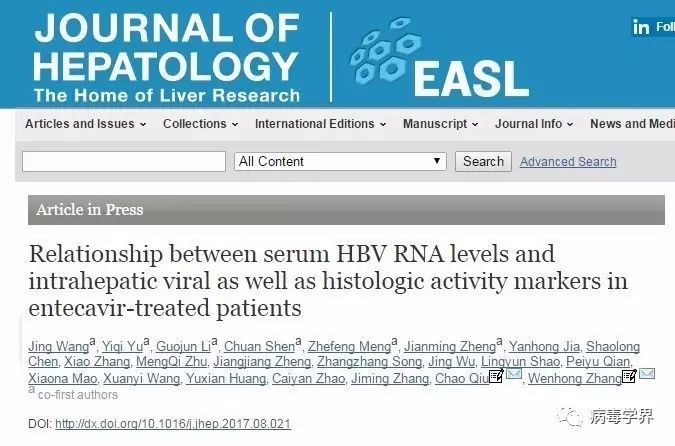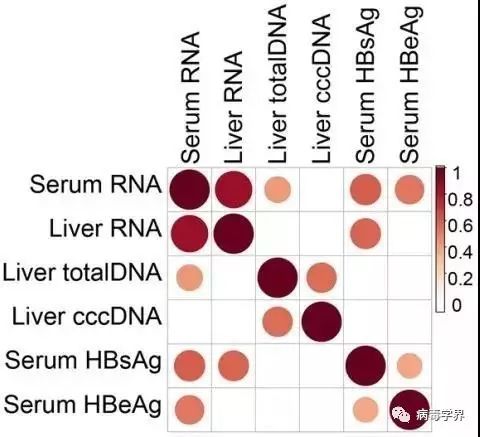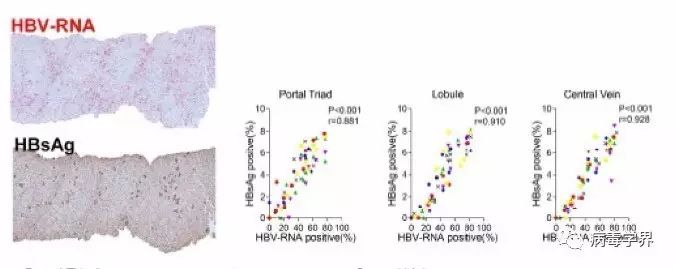【前言速递】华山医院张文宏教授团队证实血清HBV-RNA可成为功能性治愈HBV新指标。
【前言速递】华山医院张文宏教授团队证实血清HBV-RNA可成为功能性治愈HBV新指标。
近日,来自上海复旦大学附属华山医院感染科主任张文宏教授团队在Journal of Hepatology 上发文,通过结合组织学证据与临床队列证据,证实了血清HBV-RNA可成为功能性治愈新指标。

乙型肝炎病毒简称乙肝病毒。是一种DNA病毒,属于嗜肝DNA病毒科(hepadnaviridae)。根据目前所知,HBV就只对人和猩猩有易感性,引发乙型病毒性肝炎疾病。完整的乙肝病毒成颗粒状,基因组长约3.2kb ,为部分双链环状DNA( rcDNA)。目前全球估计有近2.4亿人感染。
HBV经NTCP受体进入肝细胞后,HBV rcDNA进入细胞核,短链会进行扩增延长,“填充缺口”形成cccDNA (cccDNA从头合成过程),后者作为模板指导病毒RNA合成,其中pgRNA在胞质中与病毒DNA聚合酶结合,并被衣壳蛋白包装形成核衣壳,同时pgRNA可逆转录合成rcDNA,新合成的rcDNA可进入细胞核再次生成cccDNA (cccDNA复制过程)。临床上,经核苷类药物(NUC)治疗后即使患者血清HBV DNA低于检测下限,但仍有部分患者能检测出血清HBV-RNA。因此就血清中HBV-RNA水平能否反应肝内的病毒复制中间体水平,能否成为功能性治愈新靶标,成为临床争论的热点问题。

为此,华山医院感染科张文宏、仇超等率领研究团队对恩替卡韦(ETV)治疗超过1年的慢乙肝患者分析了治疗后血清HBV-RNA和肝内HBV-RNA以及其他病毒复制中间体以及cccDNA之间的关系。研究发现在入选的47例ETV经治患者中有35例(74.47%)可以在血清中检测到HBV-RNA(2.33–4.80 log 10 copies/mL)。血清HBV-RNA不仅与肝内HBV-RNA密切相关,且与肝内HBV-RNA与HBV cccDNA的比值也显著相关。在ETV治疗过程中即使血清HBV-DNA低于检测下限,血清HBV-RNA仍处于不断变化中。这证实了即使HBV-DNA处于检测下限时,病毒仍可处于不断的复制和进化中。

此外,研究还发现血清HBV-RNA与肝组织METAVIR病理得分的相关性;通过原位杂交的方法观察到HBV-RNA阳性细胞“呈簇状”分布且与HBsAg在空间位置上较一致。提示血清HBV-RNA水平可反映肝内病毒的转录活性,且与肝组织活动度相关,与其他复制指标相关。

此项研究揭示了在慢乙肝发病机制中血清HBV-RNA存在的临床意义,以及其对核苷类药物经治患者的监测和随访具有重要价值,可作为预测乙肝临床治愈的新指标。研究得到国家自然科学基金,国家重大传染病防治重点项目,国家卫生保健科研项目,中国肝炎防治基金会天晴肝病基金,宁波鄞州区第二科学项目资助。
专家介绍

张文宏 教授
毕业于上海医科大学医学系,毕业后长期在国家重点学科华山医院感染病科从事临床工作,曾分别在哈佛大学医学院附属BI医学中心、香港大学玛丽医院进修。目前担任复旦大学附属华山医院感染科主任,兼上海市肝病研究所副所长,上海感染病学会候任主任委员,中华医学会感染病学分会常委。长期从事不明原因发热,各种疑难感染性疾病的查因与诊治,包括难治性细菌感染、结核等分枝杆菌感染、真菌感染以及寄生虫感染的诊治。擅长病毒性肝炎等慢性肝病的诊治,主张将基础研究和临床的紧密结合,善于以循证医学和最新科研进展为基础为患者设计个体化治疗方案。牵头国家“十五”攻关传染病耐药课题,国家重大传染病“十一五”攻关快速诊断技术研究项目,负责国家“973计划”重大传染病耐药项目”子课题和多项国家自然科学基金。获 “上海市优秀学科带头人”“上海市公共卫生优秀学科带头人”,教育部“新世纪优秀人才”。
原文摘要:
Background
In diagnostics, serum hepatitis B virus (HBV)-RNA levels are valuable when the HBV-DNA load in circulation is effectively suppressed by nucleos(t)ide analogue (NUC) therapy. This study aimed to determine the intrahepatic viral replication activity reflected in serum HBV-RNA and whether HBV-RNA contributes to liver histological changes in NUC-treated patients.
Methods
A cross-sectional set of serum and liver biopsy samples was obtained from entecavir-treated patients with undetectable levels of serum HBV-DNA. The correlations between HBV-RNA concentration in serum and levels of peripheral and intrahepatic viral replicative forms and histological scores were analyzed. Quasispecies of serum HBV-RNA and intrahepatic viral replicative forms were examined by deep sequencing. HBV-RNA-positive hepatocytes were visualized by in situ hybridization.
Results
Serum HBV-RNA was detected in 35 of 47 patients (74.47%, 2.33–4.80 log10 copies/mL). These levels correlated not only with the intrahepatic HBV-RNA level and the ratio of intrahepatic HBV-RNA to covalently closed circular DNA (cccDNA), but also with the histological scores for grading and staging. From the view of quasispecies, serum HBV-RNA was more genetically homogenous with contemporaneously sampled intrahepatic HBV-RNA relative to cccDNA pool and dynamically changed over time in consecutive samples. In situ histology study revealed that HBV-RNA–positive hepatocytes were clustered in foci, sporadically distributed across the lobules, and co-localized with hepatitis B surface antigen.
Conclusion
Serum HBV-RNA levels reflect intrahepatic viral tranional activity and are associated with liver histopathology in patients receiving NUC therapy. Our study sheds light on the nature of HBV-RNA in the pathogenesis of chronic HBV infection and has implications for the management of chronic hepatitis B during NUC therapy.
编辑:ipsvirus